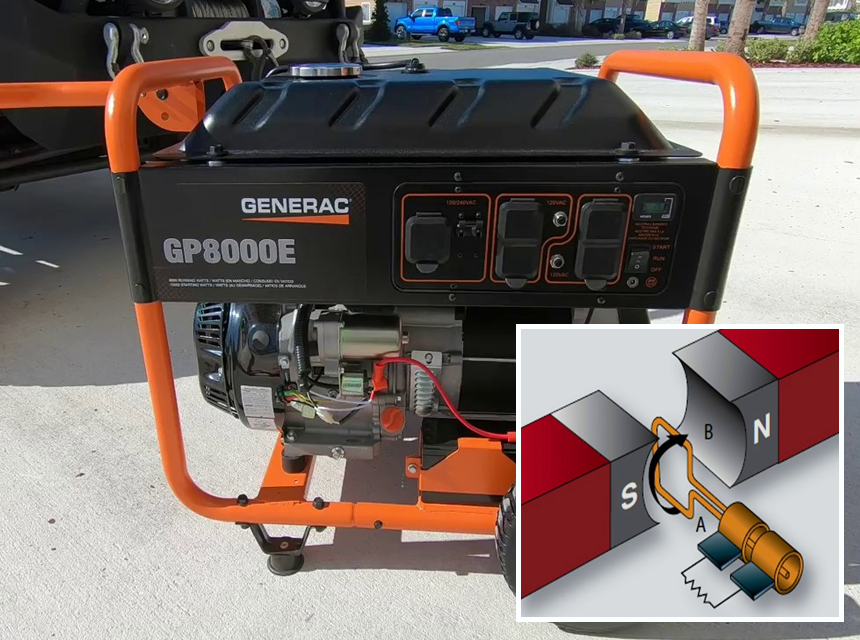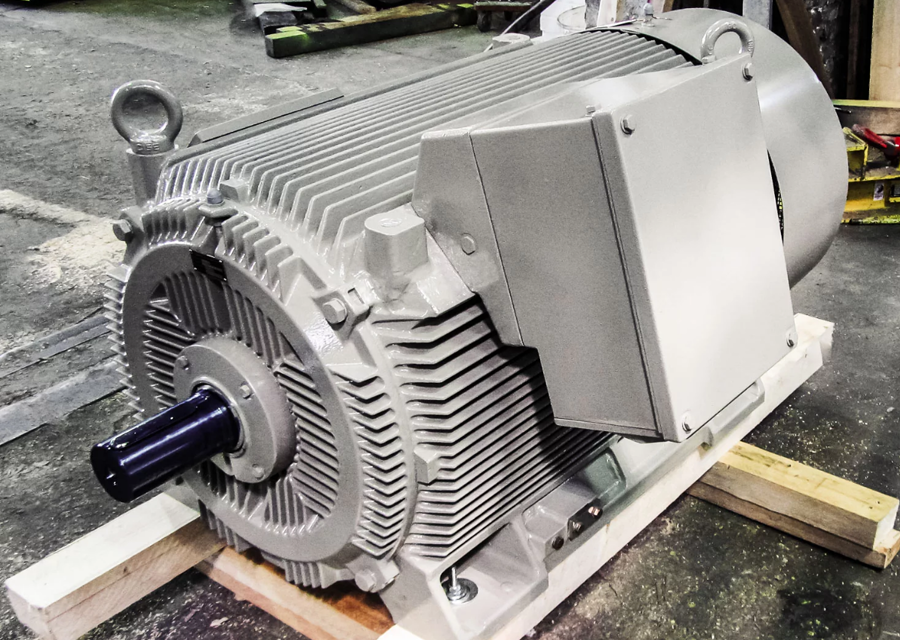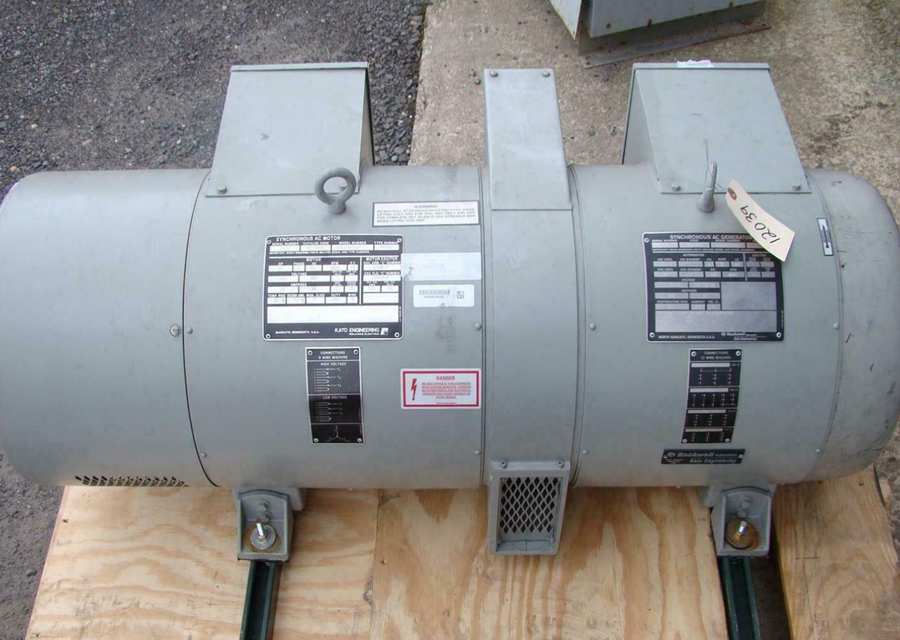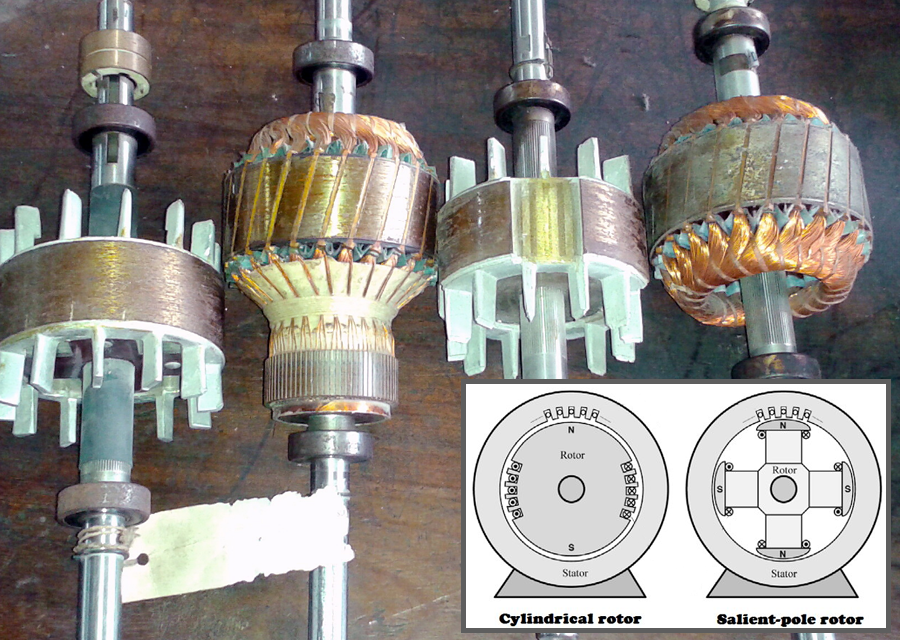
If you’re thinking of getting an AC generator, you might be confused because there are so many types, components, and classifications. The types of AC generators can differ based on the number of phases, speed, and the main kinds, which our complete guide will cover.
You also have to think about the components of the AC generator and how this unit operates in the first place. An AC generator will basically convert mechanical power to AC power. If you want to know the workings behind the AC generator before getting one, our guide provides a detailed explanation.

The electric generator will create electrical energy in the form of alternating currents. The input supply of the generator is mechanical energy, and this is provided by steam turbines, combustion engines, and gas turbines. Then, the output is alternating electrical power in the form of current and voltage.
An AC generator is usually found powering small electrical items like a computer or a coffee machine. It is the opposite of a DC generator which will power much larger systems, even those that are used to power the subway. The main difference between the AC and
DC generator
Trusted Source
electric generator - Direct-current generators | Britannica
A direct-current (DC) generator is a rotating machine that supplies an electrical output with unidirectional voltage and current. The basic principles of operation are the same as those for synchronous generators. Voltage is induced in coils by the rate of change of the magnetic field through the coils as the machine rotates. This induced voltage is inherently alternating in form since the coil flux increases and then decreases, with a zero average value.
The field is produced by direct current in field coils or by permanent magnets on the stator. The output, or armature, windings are placed in slots in
www.britannica.com
is that they convert mechanical energy to AC and DC electrical power, respectively.
AC is alternating current, which switches directions periodically by either moving backward or forward. But, DC means direct current, and the current will flow steadily in one direction. Your household outlets are AC because it is less complicated and harmful than DC. A good AC generator product that is highly recommended by reviews online is the Generac 7676.
The AC generator functions on the idea of electromagnetic induction, which is based on Faraday’s Law. The law of electromagnetic induction states that whenever a conductor is in a varying magnetic field, it induces an electromagnetic force. According to this law, the electromotive force (EMF) is created in a conductor that will cut the magnetic field.
In general, it captures the power of motion from the rotors and turns it into electrical energy, thus forcing the electrons through a circuit. When the armature on the generator rotates, and that side of the coil goes down, it induces a potential difference, giving you an alternating current, AC. The flux linkage of the armature keeps on changing, thus inducing the electromagnetic force.
AC generators have a static magnetic field and a rotary conducting coil, or it can be the other way around with a rotating magnetic field and a static conductor. The static coil can easily draw induced alternating current than a rotating coil, and it is a simple component to use. The electromotive force will depend on the field strength number.
Since AC generators mostly work at a constant speed, the maximum voltage value is always constant. It usually powers some of the well-known generators, like the best Yamaha generators.
There are different components that you will find on an AC generator, all with different functions. All the components are connected to each other and can be static or rotating. You can find them in the different types of AC generators. Here are the six main components:
Field
The field of the AC generator consists of coils of conductors. This component is in charge of getting the voltage directly from the source and using it to create a magnetic flux. This flux will be in the field and cut the armature so that it produces voltage. The voltage it produces is the output of the generator.
Armature
When you look at the armature in an AC generator, you are looking at the part that produces a voltage or electromotive force. The armature is made of coils of wire that are big enough to take the full load current of the generator. It is also used in generating a shaft torque within the machine.
Prime Mover
Another component that is found in the AC generator is the prime mover, and this is what drives or moves the generator for it to work. It can be a diesel engine, a motor, or a steam turbine. It can even be solar, like in the best solar generators. The prime mover provides the mechanical power to move a shaft in the generator and can be some sort of turbine that drives the unit.
Slip Rings
The generators require electrical connections, and these are referred to as slip rings. The slip rings focus on transferring power between the different components of the generator. They can conduct the current that is moving from a stationary component to one that is rotating. Slip rings look like holly rings, and you can find them at the end of the armature coil.
Rotor
The rotor is the rotating part of the AC generator, and it is driven by the prime mover. Also, this can differ based on the type of AC generator, as the field or armature can also act as the rotor. The rotor is a part of the excitation system and is the main component part of the AC generator. It is usually manufactured in electrical steel or wound copper.
Stator
On the opposite end of the rotor is the stator, which is any stationary part of the AC generator. It can be the field or armature, depending on the type you are working with. The electrical energy of the generator is created to supply a load to the home.
The two types of AC generators are asynchronous and synchronous. Both types provide alternating currents but have different designs and principles during operation. If you decide to use either of these, you will need to safely operate your generator Trusted Source How to safely use a generator during a power outage | CNN Incorrectly using a generator can lead to dangers including electrocution, fire or carbon monoxide poisoning. Whether you’re without power due to a natural disaster like Hurricane Ida or some other reason, here are seven ways to safely use a generator for your home. edition.cnn.com . Here are the two main types of AC generators.

Also known as an induction generator, the asynchronous generator is an AC electrical generator using induction motors to create electrical power. This works by mechanically turning the rotors, and it is faster than the synchronous speed.
To better understand, know that an induction AC generator was first a motor. But, it is connected to an electrical power system and driven by the prime mover through a turbine, windmill, or engine that is capable of supplying the torque needed to drive the motor quickly. So, the speed of the generator is determined by the prime mover.

On the other hand, the synchronous AC generator is one that produces AC voltage when the shaft is rotated. It is synchronous, meaning that the created voltage is synched with the rotation of the generator.
Thus, synchronous AC generators are mostly found producing electrical power in utility companies. This is because, as long as the rotor is being moved constantly, there is a frequent production of power.
Another way to look at the different types of AC generators is the number of phases. AC generators can be classified into single, and three phases, and what separates them is the number of armatures used in each type. The three-phase AC generator provides a more consistent voltage.
In a single-phase AC generator, every time the rotors rotate, there is one cycle. And the output is a single sinusoidal voltage or current. In other words, the generator will produce a voltage in a single wave that will alternate each time, as long as there is a magnetic field and the armature is rotating.
A single-phase AC generator will provide a fluctuating voltage through the wave cycle. They are mostly used as an alternative when the main power supply of a residential or commercial space is cut off, i.e., during a blackout. Reviews have stated that the WEN DF1100T is also great for a backup generator. They come in handy in places where there is no regular power supply.
What differentiates a single-phase and a three-phase AC generator is the fact that the latter has three armatures, and there is a 120-degree shift in rotation. The generator will be operating sequentially, and the 120-degree offset will be between them, taken two at a time. In one cycle, the generator will produce three waves of voltage for a constant supply.
Three-phase AC generators are more efficient in providing uninterrupted electric supply with no fluctuations, constant torque, and fewer vibrations. They are useful in areas where there is a very high need for constant power, like electric motors and data centers. It is also needed for places that run heavy-duty equipment.
When looking at the types of AC generators, you can also consider the speed that they provide. Let’s take a closer look.

Anyone looking for speed will go for the smooth cylindrical AC generator, which rotates at a really high speed with its turbine. The high-speed generator matches with the power turbine to provide consistent current. The rotor on this type of generator has a particular number of slots at intervals on the outer edge of the field.
The generator is designed with two poles for 3600 rpm or 4 poles for 1800 rpm, which are really high speeds. Smooth cylindrical generators don’t have separate damper windings, and the poles don’t project. It is strong enough to power steam turbines.
On the other end is the salient pole generator that is suitable for low to medium-speed applications. The AC generator features a lot of projecting poles that are bolted to the magnetic wheel. They have a large diameter and appear like a wheel.
The salient pole generator usually has speeds from 125 rpm to 500 rpm, which is much lower than the smooth cylindrical. It has separate damper windings with no air gap. It can be used to power low-speed turbines like hydel power plants Trusted Source Types of Hydropower Plants | Department of Energy There are three types of hydropower facilities: impoundment, diversion, and pumped storage. www.energy.gov . They are mechanically weak and can only work at low speeds.
AC generators can be found in a wide range of daily applications, from electric scooters and microwaves to powering sailboats and household electricity. You can find it in the wind, steam, or hydro energy plants. Here are the main advantages of using AC generators:
Now that you know the types of AC generators, you can easily choose one that works best for you. You can choose based on the main types, which are synchronous and asynchronous AC generators. Another option is to choose based on speed or the number of phases. It might be a bit difficult to get this in your head, but you should consider your electrical needs and requirements before choosing any AC generator.